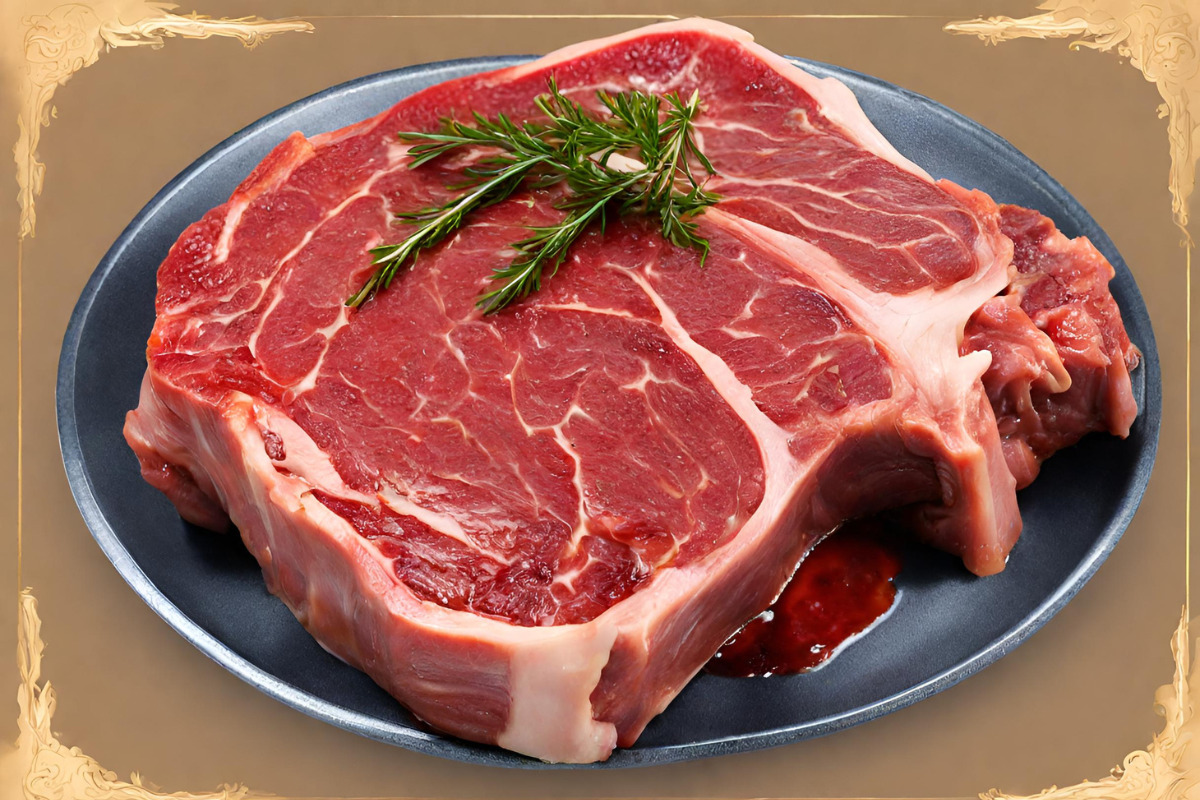Introduction to the Article on Beef Shank
This guide covers all about beef shank, from nutrition to cooking methods and recipes, helping you master its culinary potential.
Introduction to Beef Shank
What is Beef Shank?
The leg part of a steer or heifer is known as the beef shank. Due to its location, it is one of the more muscular cuts, imbued with thick, fibrous muscles. This cut is well-known for its rich, deep flavor and is often used in dishes that require slow cooking to break down the tough fibers, resulting in tender and juicy meat.
Importance in Culinary Practices
Across various cuisines, the beef shank is celebrated for its ability to enhance the flavors of stews and soups. The bone in the middle, filled with marrow, adds a rich complexity to broths and sauces that is hard to replicate with other cuts. This characteristic makes it a favorite among chefs who aim to achieve a robust taste and hearty consistency in their dishes.
By understanding these foundational aspects of beef shank, home cooks and professionals alike can start to appreciate the versatility and depth this cut brings to the kitchen table. Whether you’re simmering a slow-cooked stew or preparing a comforting broth, the beef shank proves to be an indispensable ingredient in creating flavorsome and nourishing meals.
Nutritional Profile
Nutritional Benefits of Beef Shank
The beef shank is not only prized for its flavor but also for its nutritional value. It is an excellent source of protein, essential for muscle repair and growth. Moreover, it provides vital minerals such as iron, which helps in the production of hemoglobin, and zinc, crucial for a healthy immune system. The presence of these nutrients makes the beef shank a beneficial addition to a balanced diet.
Comparing Caloric Value
When compared to other cuts of beef, the beef shank stands out for its lower fat content, making it a leaner option. This characteristic translates into a lower caloric value, which can be particularly appealing to those monitoring their calorie intake. Embracing this cut can be a smart choice for health-conscious individuals who don’t want to compromise on taste while maintaining a nutritious diet.
By incorporating beef shank into your meals, you not only enrich the dish with deep flavors but also benefit from its substantial nutritional offerings. Whether you’re looking to boost your protein intake or seeking a leaner meat option, the beef shank meets a wide array of dietary needs, making it a versatile and healthful choice in your cooking repertoire.
Cooking Techniques
Best Methods to Cook Beef Shank
The beef shank requires specific cooking methods to transform its tough fibers into a tender, delectable meal. Here are the best techniques to achieve the optimal texture and flavor:
Braising
Braising is a moist-heat cooking method that involves cooking the beef shank slowly in a flavored liquid. This technique allows the tough connective tissues to break down over time, resulting in meat that is incredibly tender and infused with the flavors of the braising liquid. To braise a beef shank, first, sear it to develop a rich, caramelized crust, then slowly cook it in a broth with your choice of herbs and vegetables.
Slow Cooking
Another excellent method for cooking beef shank is using a slow cooker. This approach requires minimal effort but yields maximum flavor. Simply place the beef shank in the slow cooker, add a mix of broth and seasonings, and let it cook on low for several hours. The slow cooker envelops the beef shank in steady, low heat, ensuring that it becomes tender and moist.
Cooking Times and Temperatures
To achieve the best results when cooking beef shank, it’s important to maintain low cooking temperatures over an extended period. Generally, braising or slow-cooking the beef shanks at around 275°F (135°C) for 3-4 hours will allow the meat to become perfectly tender. The key is to give the tough fibers enough time to break down without drying out the meat, preserving its juiciness and flavor.
Master these techniques to unlock beef shank’s potential, ensuring tender, flavorful dishes with patience.

Recipes and Uses
Classic Recipes Using Beef Shank
The beef shank shines in many traditional dishes, imparting a depth of flavor that is hard to match. Here are a couple of classic recipes that highlight its robust taste:
- Osso Buco: This Italian specialty translates to “bone with a hole,” referring to the marrow bone at the center of the beef shanks. Osso Buco is traditionally braised with onions, carrots, celery, tomatoes, and white broth, creating a rich, hearty dish often served with risotto.
- Beef Shanks Stew: Perfect for cold months, this stew features slow-cooked beef shanks with potatoes, carrots, and herbs in a rich broth. The result is a comforting dish that warms the heart and fills the belly.
Innovative Ways to Utilize Beef Shanks
Beyond traditional recipes, the beef shanks is incredibly versatile, lending itself to a range of innovative culinary uses:
- Pulled Beef Sandwiches: After slow-cooking, the beef shanks can be easily shredded to make pulled beef sandwiches. Combine the meat with a homemade barbecue sauce and serve on toasted buns for a satisfying meal.
- Beef Shanks Tacos: Infuse your tacos with a twist by using tender beef shanks meat. Top with fresh cilantro, diced onions, and a squeeze of lime for a delightful fusion of flavors.
Exploring recipes enhances meals, making beef shanks a versatile, flavorful choice for any chef
Pairings and Servings
What to Serve with Beef Shanks
To complement the rich flavors of beef shanks, consider these pairing options that enhance the overall dining experience:
- Roasted Root Vegetables: The earthiness of roasted carrots, parsnips, and potatoes matches the hearty nature of beef shanks dishes, balancing the meal with their natural sweetness.
- Creamy Polenta: For a smoother texture contrast, creamy polenta serves as a perfect base, soaking up the succulent sauces from braised beef shanks dishes.
Portion Sizes and Presentation Tips
Serving the beef shanks attractively is key to elevating the dining experience. Here are some tips for portioning and presenting this meat cut:
- Generous Portions: Given the long cooking times required for beef shanks to reach its tender best, it typically reduces in size. Ensure portions are generous enough to satisfy hearty appetites.
- Garnishing for Impact: Adding fresh herbs like parsley or thyme enhances the dish’s visual appeal and flavor.
Careful pairing and presentation of beef shank create meals that are delicious and visually appealing. Perfect pairings and thoughtful presentation elevate the humble beef shank into a gourmet experience, delighting guests and making meals memorable.
Preservation and Storage
Storing Beef Shank Properly
To maintain the quality and safety of <em>beef shank, proper storage is crucial. Here are some guidelines:
- Refrigeration: Fresh beef shanks should be stored in the refrigerator if it’s to be cooked within a few days.
Wrap beef shank tightly in plastic or an airtight container to prevent air exposure and spoilag.
- Freezing: Freezing is the greatest solution for long-term storage. Wrap the beef shanks securely in freezer-safe wrap or bags, removing as much air as possible to prevent freezer burn. Properly stored, beef shanks can last up to 12 months in the freezer without losing its quality.
Shelf Life Considerations
The shelf life of <em>beef shank can vary based on storage conditions:
- In the Refrigerator: When properly refrigerated at or below 40°F (4°C), fresh beef shank can last 3-5 days.
- In the Freezer:</strong> Frozen <em>beef shank, when stored correctly, can remain at peak quality for up to a year. However, it remains safe beyond this period, although its quality may begin to degrade.
Storing beef shank properly maintains flavor, texture, and nutritional value, ensuring delicious, safe meals.

FAQs
Frequently Asked Questions
Here are answers to some common questions about beef shanks that might help clarify any uncertainties you have about using this flavorful meat cut:
-
How do I know when the beef shanks is fully cooked?
- Beef shanks is fully cooked when it is tender enough to be easily pierced with a fork. The internal temperature should reach at least 145°F (63°C) for it to be safe to eat, though for braising, temperatures of around 190°F to 200°F (88°C to 93°C) are often targeted for optimal tenderness.
-
Can beef shanks be cooked quickly on high heat?
- Due to its tough fibers and muscle structure, beef shanks is not suitable for quick, high-heat cooking methods like grilling or frying. It is best prepared using slow cooking techniques such as braising or stewing to break down the tissues and achieve a tender texture.
-
What are the best seasonings or marinades for beef shanks?
- Beef shanks pairs well with robust seasonings and marinades. Ingredients like garlic, rosemary, thyme, and bay leaves enhance its rich flavor. For marinades, consider acidic components like tomato sauce or vinegar to help tenderize the meat further.
-
Is beef shanks suitable for making broth or stock?
- Absolutely! The beef shanks is excellent for broths and stocks because of the bone and marrow content. Simmering it for several hours extracts rich flavors and nutrients, making a base that’s ideal for soups and stews.
These FAQs help cooks maximize their beef shanks dishes, ensuring delicious, properly prepared meals.
That concludes our comprehensive guide on beef shanks.This guide covers nutrition, cooking methods, recipes, and storage for *beef shank*, enhancing your culinary creations.. Remember to follow the storage and cooking tips to ensure the best flavor and safety of your dishes. Happy cooking, and enjoy the delicious depth that beef shanks brings to your table!

